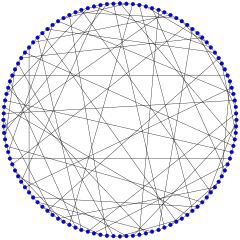Balaban 11-cage
| Balaban 11-cage | |
|---|---|
|
The Balaban 11-cage | |
| Named after | A. T. Balaban |
| Vertices | 112 |
| Edges | 168 |
| Radius | 6 |
| Diameter | 8 |
| Girth | 11 |
| Automorphisms | 64 |
| Chromatic number | 3 |
| Chromatic index | 3 |
| Properties |
Cubic Cage Hamiltonian |
In the mathematical field of graph theory, the Balaban 11-cage or Balaban (3-11)-cage is a 3-regular graph with 112 vertices and 168 edges named after A. T. Balaban.[1]
The Balaban 11-cage is the unique (3-11)-cage. It was discovered by Balaban in 1973.[2] The uniqueness was proved by McKay and Myrvold in 2003.[3]
The Balaban 11-cage is a Hamiltonian graph and can be constructed by excision from the Tutte 12-cage by removing a small subtree and suppressing the resulting vertices of degree two.[4]
It has chromatic number 3, chromatic index 3, radius 6, diameter 8 and girth 11. It is also a 3-vertex-connected graph and a 3-edge-connected graph.
Algebraic properties
The characteristic polynomial of the Balaban 11-cage is :

 .
.
The automorphism group of the Balaban 11-cage is of order 64.[4]
Gallery
-

The chromatic number of the Balaban 11-cage is 3.
-

The chromatic index of the Balaban 11-cage is 3.
-

Alternative drawing of the Balaban 11-cage.[1]
- ^ P. Eades, J. Marks, P. Mutzel, S. North. "Graph-Drawing Contest Report", TR98-16, December 1998, Mitsubishi Electric Research Laboratories.
References
- ↑ Weisstein, Eric W., "Balaban 11-Cage", MathWorld.
- ↑ Balaban, A. T. "Trivalent Graphs of Girth Nine and Eleven and Relationships Among the Cages." Rev. Roumaine Math. 18, 1033-1043, 1973.
- ↑ Weisstein, Eric W., "Cage Graph", MathWorld.
- ↑ 4.0 4.1 Geoffrey Exoo & Robert Jajcay, Dynamic cage survey, Electr. J. Combin. 15 (2008)
